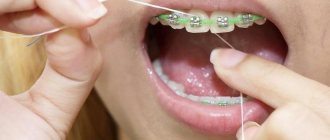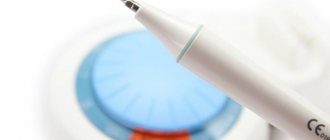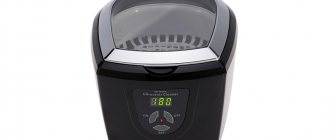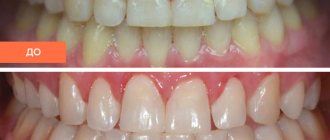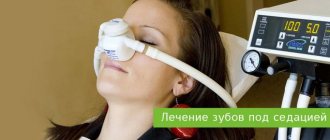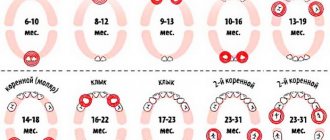Why is the procedure needed?
Professional teeth cleaning is a preventive and aesthetic procedure. It solves 7 problems at once:
- prevents the development of caries and inflammatory gum diseases;
- makes teeth whiter;
- carried out as preparation for complex dental treatment (implantation, bite correction, prosthetics);
- adds self-confidence;
- reduces the risk of complications after complex dental treatment;
- removes dark marks caused by coffee, cigarettes and food dyes;
- solves the problem of bad breath if it is caused by tartar.
During home brushing, mineralized plaque remains on the teeth. It can only be removed using professional tools and methods. Therefore, dental cleaning is a necessary procedure for anyone who wants to maintain healthy teeth.
How often should I clean?
Hygienic cleaning must be carried out every morning and evening. Professionally, the procedure is carried out once every six months. This is enough to maintain the result. Additionally, cleaning may be necessary before undergoing complex dental treatment or if you regularly drink coffee or smoke cigarettes.
.
Recommendations after professional oral hygiene
After professional oral hygiene, all rules and recommendations are aimed at preserving the results of the procedure. In the first few hours, it is forbidden to drink colored drinks and foods (wine, tea, coffee, beets, citrus fruits, etc.), as well as smoke cigarettes. In the first two days, it is not recommended to eat too rough and hard food. High-quality oral care at home will help prolong the results of professional hygiene: many experts advise purchasing a good ultrasonic brush or irrigator. These devices can effectively combat the accumulation of plaque in hard-to-reach places.
A unique, multifunctional device that combines an electric sonic toothbrush, an irrigator and dental floss. The components and the device itself are stored in a convenient plastic container, which is ideal for traveling or storing in a small bathroom.
Types and differences
Professional teeth cleaning can be done in a variety of ways. Each of them has both advantages and disadvantages. The patient’s wishes are taken into account when choosing a technique, but the final decision is made by the doctor, taking into account contraindications and the condition of the teeth.
Ultrasonic
The most effective way to remove solid deposits is ultrasonic cleaning. With its help, tartar is removed. A special device is used for this: it can be built into the dental unit or made as a separate unit. This is an ultrasonic scaler.
There is a working nozzle at the tip of the device. Its tip makes oscillatory movements at an ultrasonic frequency of 25-50 kHz. Additionally, water or an antiseptic solution is supplied to the nozzle. They enhance the cleansing effect due to cavitation - vibrations of water dipoles with the formation of bubbles. Excess fluid is removed using a saliva ejector.
Ultrasonic cleaning, when carried out correctly, does not damage the enamel. It allows you to remove not only tartar, but also bacteria due to the supply of an antiseptic solution and the bactericidal effect of cavitation. Supra- and subgingival deposits are also removed. The procedure is absolutely painless and comfortable.
Laser teeth cleaning
Teeth cleaning with a laser is quick. The beam is directed onto the surface of the teeth, causing the water in the plaque to evaporate. Residues are washed off with a water jet under pressure.
Teeth cleaning with a laser requires expensive equipment. It is significantly higher in price than the others.
Sandblasting
Teeth cleaning by sandblasting is carried out using an Air Flow device. This is a modern and effective way to remove old plaque. For cleaning you need a device with attachments, a mixture of fine abrasive and a fixing gel. Cleansing powders are produced with pleasant flavors, which makes the procedure more comfortable.
Hygiene with Air Flow is not suitable for removing tartar. But the device copes well with old soft plaque. It does not harm enamel, but should be used with caution in people with sensitive gums.
Is it painful to have professional cleaning?
Patients often wonder if it hurts to have their teeth cleaned at the dentist. Regardless of the method used, there is no pain. A feeling of discomfort may occur when removing mineralized formations. In this case, ultrasound is prescribed. Ultrasonic teeth cleaning is also recommended during pregnancy and increased tooth sensitivity.
Dry cleaning
For professional hygiene, a special gel containing acid and hydrogen is applied to the teeth. The composition is kept for several minutes. Under the influence of chemicals, tartar is destroyed. It is then easily cleaned off with water.
The technique is painless and effective, but plaque in the interdental spaces cannot be removed in this way. The composition also has an adverse effect on the gums, so it is better not to use it for people with closely located vessels.
Mechanical teeth cleaning
The simplest method of professional dental hygiene. It is carried out using dental instruments, highly active pastes and brushes. This takes longer than other cleaning methods. There is a risk of damage to the enamel. Therefore, the mechanical method is used quite rarely.
Fluoridation of teeth
After professional cleaning, teeth are often fluoridated. It performs 4 functions:
- strengthens enamel;
- reduces tooth sensitivity;
- slows down the growth of bacteria;
- reduces the negative impact of an acidic environment.
To do this, the surface of the teeth is coated with fluoride varnish. To do this, use a special brush or mouth guard with gel.
What not to do after prof. cleaning?
When a person has spent time and money, visited a dentist and received an excellent result in the form of clean teeth and a snow-white smile, the desire to preserve all this for a longer time becomes understandable. Therefore, it is important to follow the following general recommendations:
- do not eat or drink (especially drinks with dyes) for 2 hours after the procedure;
- Replace an old toothbrush that contains bacteria with a new one;
- for 7 days, eat less foods that can stain tooth enamel (coffee, wine, tea, etc.);
- rinse your mouth after every meal;
- regularly brush your teeth with the correct movements, use special threads;
- Go to the dentist once every six months.
Contraindications to the procedure
Like any medical procedure, professional dental hygiene has contraindications:
- age under 18 years;
- inflammatory diseases of the oral cavity;
- foci of caries;
- bronchial hyperreactivity (in patients with asthma, allergies, obstructive bronchitis);
- severe thinning of the enamel layer;
- bruxism;
- some mental pathologies;
- chronic diseases in the acute phase;
- infectious pathologies;
- a large number of filled teeth;
- epilepsy; open form of tuberculosis;
- wearing braces and metal crowns.
Most contraindications are relative. The patient can undergo the procedure after recovery.
Harm
Air abrasive treatment consists of particles of soda NaHCO3 (or silicon oxide SiO2, calcium carbonate CaCO3, etc.) flying out of the dental apparatus under pressure and knocking out the surface layer of dental plaque. In addition to dental plaque, the outer part of the enamel is also removed (a very small amount, invisible to the eye). The fear of completely wearing off your enamel with annual cleanings is not justified, however, after using AirFlow, the tooth surface becomes uneven. And not only where the plaque was, but also in neighboring areas (where soda powder gets). This leads to rapid re-adhesion of plaque. To eliminate this drawback, it is recommended to polish the teeth with brushes and pastes after brushing in the dentist’s chair. However, it should be understood that a rotating brush may not reach all places on the tooth where mini-particles of soda have been. Most contact surfaces are poorly polished.
Another disadvantage of air abrasive treatment is the inevitable injury to the gums. The gums, in the presence of dental plaque, are inflamed to one degree or another, and contact with a stream of soda powder causes it to bleed. In sensitive patients, it can also cause pain. Bleeding goes away on the same day, but post-traumatic symptoms disappear completely within a week. Although most people do not pay attention to these minor troubles, some experience noticeable inconvenience.
It is extremely rare, but still such a complication as airborne emphysema occurs. If the marginal attachment is damaged, air from the AirFlow device under pressure penetrates the soft tissue. The gums and cheek increase in volume, and when you press on them, a crepitating sound is heard. The appearance of a swollen face greatly frightens the patient himself. But in the vast majority of cases, emphysema does not cause serious problems or complications. No intervention is needed to eliminate it. After a short time it goes away on its own. To prevent infection, you can take a course of antibiotics.
To prevent the formation of air emphysema during subsequent professional cleanings, AirFlow should be performed before ultrasonic treatment, and not after.
Ultrasound, if used carelessly or incorrectly, can create enamel cracks. Such cracks by themselves do not lead to subsequent destruction. But the mechanical strength still decreases, and when other factors (trauma or caries) are added, the weakened enamel flies off more often. Over the years, the crack can accumulate food pigments and turn dark. This does not lead to caries, but the appearance worsens.
The pain from ultrasonic cleaning is higher than from air-abrasive cleaning. It also usually goes away within a week, but ultrasound is more difficult to endure. Approximately 98% of patients do without anesthesia; for the most sensitive 2 percent, professional hygiene with anesthesia is recommended. To completely “freeze” the oral cavity, 6-10 injections are required. In this case, “spraying” or “anointing” the gums will not work - application anesthesia anesthetizes only soft tissues, and with ultrasonic cleaning, the teeth, not the gums, hurt. A large number of injections may not have the best effect on the patient’s general condition, so it is advisable to split the procedure into two doses. First, for example, brush only the upper teeth under anesthesia, and the lower teeth at the next visit.
Types
Some patients, out of ignorance, do not distinguish between teeth cleaning and teeth whitening - these are different events, each aimed at its own result. Several types of cleaning have been developed in dentistry, the most popular:
- ultrasonic scaler;
- laser machine;
- "air flow";
- hygienic (manual).
Each of these types of cleansing has pros and cons. The methods are designed to get rid of problems (according to severity level).
- Ultrasonic cleaning optimizes the condition of the gums and stops bleeding. The scaler has several contraindications.
- Laser cleaning kills microorganisms and has a healing property – it heals mouth ulcers.
- “Air flow” cleaning is performed using an air stream with an abrasive. There are contraindications.
- Hygienic cleaning is a method of removing plaque using specialized dental brushes and hooks - this is a gentle method of removing tartar. Today, hygiene procedures at the dentist are used less frequently than others.
Only a dentist can choose the right way to clean enamel. When choosing, he takes into account the method suitable for a particular patient, age, and dental condition.
The benefits and harms of stone removal
The benefits of professional teeth cleaning are as follows.
- The enamel becomes smooth, it better absorbs the beneficial substances contained in therapeutic, prophylactic and medicinal toothpastes.
- Pathogenic microbes that cause the development of dangerous diseases are eliminated.
- The procedure is a prevention of gingivitis and periodontal disease, which are the cause of tooth decay.
- Eliminates unpleasant odor from the mouth.
- The natural whiteness of the enamel is restored.
There is rarely any harm from professional teeth cleaning. Sometimes the procedure can damage the gums. This happens with increased sensitivity.
Cleaning teeth from plaque in dentistry is an indispensable procedure for maintaining oral health.
It should be done regularly to prevent the development of caries, periodontal disease, gingivitis and their complications. After weighing the pros and cons of professional teeth cleaning, you should visit your dentist regularly. The doctor's consultation
Teeth brushing “air flow”
This type of procedure requires a dental device that performs cleaning with a highly targeted, powerful air jet. Air under enormous pressure quickly blows away plaque, traces of nicotine and food.
Some patients experience teeth whitening by several shades after this medical procedure, but such a side effect does not always happen.
After removing the plaque, if a person returns to the old lifestyle, the color of the teeth returns to their original state, they again acquire their natural shade. For the procedure to be effective, an abrasive and water are used. The abrasive used is baking soda, which does not harm the body and enamel. The advantage of this option is that the results last for a long period.
A variation of the “air flow” technique is the “perio-flow” procedure, which focuses on crushing stone under the gums. For this procedure, instead of soda, another abrasive based on a medical substance is used. Contraindications to the use of “perio-flow” are gum diseases, because it provokes an inflammatory process.

